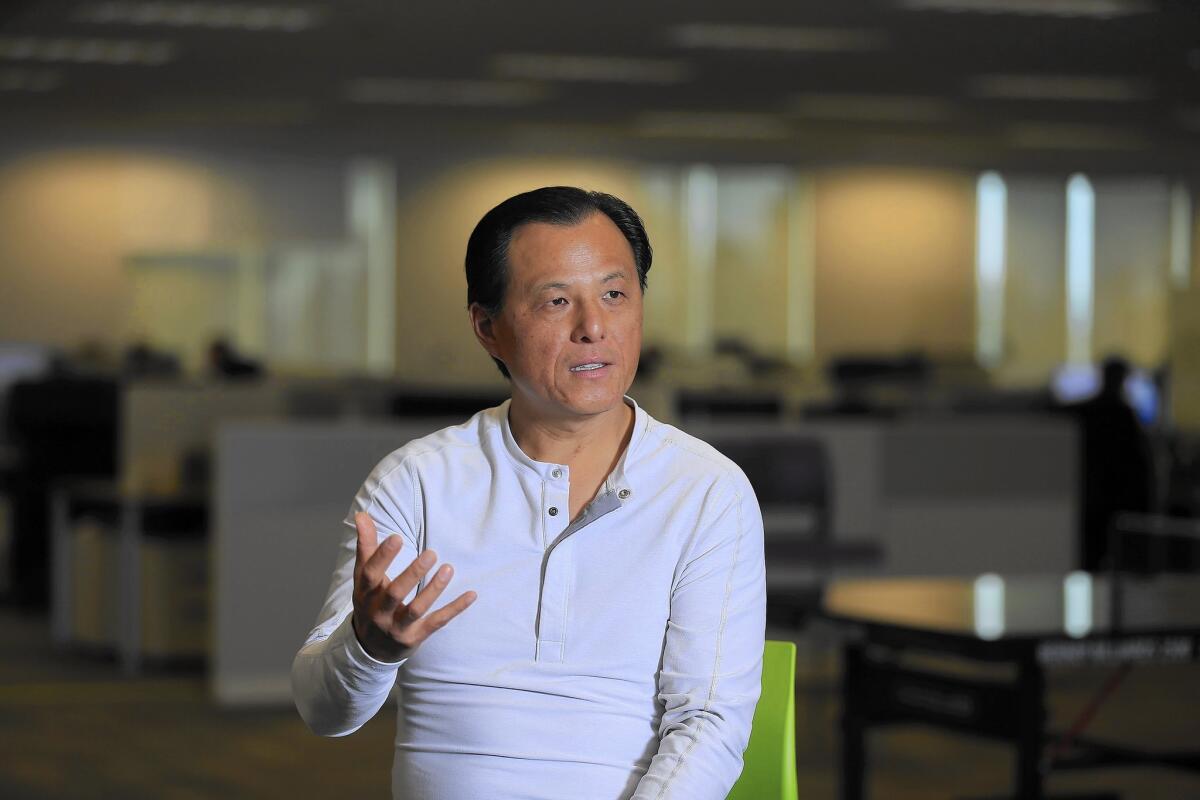Q&A: LoanDepot CEO Anthony Hsieh is banking on growth

- Share via
Foothill Ranch lender LoanDepot is less than a decade old, but it’s quickly become one of the nation’s biggest mortgage firms — and it’s still growing.
It’s one of a handful of alternative lenders, led by market leader QuickenLoans, that have picked up a big share of the mortgage market as banks have pulled back. Last year, LoanDepot issued $29 billion in loans, more than double the volume it originated in 2014, and also ramped up profits. It made $58 million in the first half of last year after making $15 million in all of 2014.
Anthony Hsieh, the firm’s founder and chief executive, hopes to keep that growth going, in part by allowing borrowers to get mortgages through a completely online process, something he has been striving for since the late 1990s.
Still, there have been setbacks. In November, the company scrapped a plan to go public, a move that now looks prescient. The initial public offering was scheduled for what turned out to be a tumultuous week for Wall Street, one that came just before a stock market rout that sent the Standard & Poor’s 500 index down more than 10% in the next three months amid concerns about the economy.
The Times spoke to Hsieh about LoanDepot’s IPO prospects, how the mortgage business has changed since he started his first online-focused mortgage firm and whether LoanDepot is a mortgage lender or a tech company. Here is an excerpt of that conversation.
When will you go back to the public markets?
It is a trigger that we can pull at any given time. The market today is not friendly. We have no control over that, but once that changes, it is an option. That’s the beauty of a profitable, positive-momentum company.
The market’s sentiment is tied into concerns over the economy, which is closely linked to the housing market. What’s your take on the future of housing market, the key driver of your growth?
The U.S. housing market today is in a unique position compared to historical cycles. This is especially true now that international buyers have a relevant portion of real estate holdings in most major markets, along with institutional holdings. With the formation of households by millennials, steady income growth and low interest rates continuing for at least this year, housing should remain at healthy levels with affordability.
LoanDepot started out offering just mortgages, but you now offer personal loans, something most mortgage lenders don’t. Why add personal loans to the mix?
Americans are serial credit users. They don’t just use credit one time. They use credit repeatedly. If your organization doesn’t have these other products, the customer will go to a personal loan lender who might ultimately start offering home loans. And if they do that, the customer could be lost for life. Before, everybody was segmented. Someone handled personal loans, someone handled car loans, someone handled home loans. Now, if car loan lender in the future starts offering mortgages, I am going to lose that customer.
In filings for your IPO, you positioned LoanDepot as more of a tech company, which would demand a higher valuation than publicly traded mortgage lenders like PHH and PennyMac. Afterward, you even called LoanDepot a “unicorn.” Do you need to rethink that story?
LoanDepot is a platform story, not just a mortgage story. Mortgage is a big piece of it and is also the biggest opportunity. What was interesting is when we were out on the road show ahead of the IPO, we were never compared to PHH or PennyMac. We are fundamentally different. Other firms didn’t have our market growth. We went, in six years, to a $1-billion revenue company that has been profitable and is fueling its own growth. To compare us with any other company I think would be difficult, other than to our No. 1 competitor, which is QuickenLoans.
But investors don’t seem sold on other lending “platforms.” Lending Club, a personal lender, and On Deck, a small-business lender, also call themselves platform lenders, and they have seen their stocks fall dramatically.
At the end of the day, it is the public investor sentiment that matters. If you look at Lending Club’s last four or five quarterly announcements, they did exactly what they said they were going to do, but they still got penalized over it. The reason why is purely public investor sentiment, which is, “Wow, when are you finally going to make money?” The sentiment plays into our position a lot.
You started LoansDirect.com in 1999. It was the early days of the online mortgage business. What has changed since then?
That was when, for the first time, a consumer could log on to LoansDirect.com, fill out all the necessary info and it returned a digital approval. The approval would be a conditional approval — that is, if you told me you make $5,000 a month, you’re approved based on us verifying that. Even today, much of it is still conditional approval. We’re getting close to a final, not conditional, approval.
What needs to change to get to that point?
Income documentation, the appraisal, bank statements — most of these requirements are still manually done today in the industry. Moving forward, most of that will be automated and digital. That really cuts down on the amount of labor that is required and most importantly it cuts down on the level of work and time invested from a consumer that wants to get a home loan.
If I apply for a mortgage from LoanDepot, how much of that process am I able to do just on my phone or my computer?
We certainly will allow the customer to dictate the involvement that they want to have. Some consumers, as an example, don’t want to talk to us. They’ve done many home loans. They’re very savvy. They just want us to service them. The communication is 100% digital. There are some consumers that prefer to talk to us. So we employ this hybrid model where we allow the consumers to tell us what they are comfortable with and how they want to interact with us.
QuickenLoans ran a Super Bowl ad about how quickly it can offer mortgages through a new app, leading to people buying other stuff and boosting the economy. I think it struck a nerve with people who remember how easy it was to get a loan before the bust. Shouldn’t getting a loan of hundreds of thousands of dollars be a little bit of a hassle?
No. That a home loan can take 30 or 40 or 50 or even, at a bank, 60 days is completely ludicrous. You are not going to find out any more data in 30 days than you can find out in the next 30 minutes. That type of grind to the consumer and the anxiety of whether I can get approved or not approved is completely not necessary.
As a consumer, why do I need the process to be faster?
Imagine you’re in the middle of escrow and, at the same time, you’ve been putting off the decision about buying a new car. You call your loan officer and say, “I’m on my way down to the auto dealership to trade in my 7-year-old car for a new car.” The first thing your loan officer is going to tell you is, “Don’t do that until after you close escrow,” because what is going to happen is you are going to increase your monthly debt payments and that might trigger something. So instead, you close your home loan, you move in and then the very next day you go and buy a new car. Did that change your risk position? No. It’s just not logical. If you don’t trust this person to buy a new car, why would you give this person a 30-year loan?
Twitter: @jrkoren
More to Read
Inside the business of entertainment
The Wide Shot brings you news, analysis and insights on everything from streaming wars to production — and what it all means for the future.
You may occasionally receive promotional content from the Los Angeles Times.











